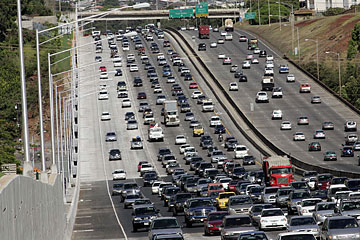
FL MORRIS / FMORRIS@STARBULLETIN.COM
The state opened the sixth westbound lane on the H-1 freeway at Waimalu yesterday. Traffic in the new sixth lane, above, was light at times.
|
|
Headaches linger as
H-1 lane opens
Residents living near the construction say it has left a permanent mark on their lives
One official said a new westbound lane on the H-1 freeway near Pearl City made the afternoon rush hour traffic smoother yesterday, but residents said the widening has changed their lives forever.
"It seems to be moving better than before we opened the lane," said Scott Ishikawa, spokesman of the Department of Transportation, who stood along the Kaahumanu Street overpass at about 4:30 p.m. yesterday to observe traffic flow.
But Barbara Paulo of Ponohale Street said, "Our ordeal is not over. It's going to be a continuous impact on our lives forever. They totally changed my whole quality of life. People don't realize how bad it is."
Area lawmakers from Mapunapuna to Ewa Beach along with Lt. Gov. James "Duke" Aiona attended a blessing ceremony before the Department of Transportation officially opened the new lane yesterday.
The two-year H-1 Waimalu widening project started in June 2004. Cost was estimated at $60 million. The sixth lane that was extended to the Pearl City offramp is expected to shed five to 10 minutes of travel time for westbound motorists and alleviate bottlenecks in that area, state Transportation Director Rod Haraga said.
"With 225,000 vehicles using this stretch of the freeway every day, we're hoping these improvements will serve everyone that take their afternoon drive from downtown over to Central and Leeward Oahu," Haraga said.
As drivers adjust to the new lane configuration, state transportation officials advised motorists to be cautious.
At the ceremony, Rep. K. Mark Takai (D, Newtown-Pearl City) said the project actually took 10 years, after an area resident suggested in October 1996 that the shoulder lane be transformed into a sixth lane during the afternoon rush hour.
But once the ZipperLane opened, plans to alter the shoulder lane were shelved, Takai said. Thereafter, he started working with state and federal officials to obtain funding for the sixth lane.
Takai stressed that the widening project did not come without "pain."
"We lost a church. We lost 10 houses, 10 neighbors," Takai said. "We had many, many months of restless nights."
"It was nothing short of miserable," Paulo said.
Paulo, who was born and raised in Waimalu Gardens located below the freeway, said her complaints of noise and dust went unheard by state officials since the inception of the project.
Despite the completion of the project, Paulo said she and her family will still be burdened by noise and falling debris now that the freeway is 30 feet closer to her home.
Juanita Rabanal, who lives a couple of homes away from Paulo, said her entire home vibrated as contractors used heavy machinery including sandblasters and jackhammers, causing cracks to form in her tile floor.
Also, cement dust and red dirt constantly blew into her home, affecting Rabanal's 8-year-old grandson, Izhek Sandoval, who has asthma.
Of the new lane, Rabanal said, "I hope this works, because we had to go through hell the last two years."
Takai said he plans to continue to address residents' ongoing concerns of debris falling over the freeway and noise. "We're going to work on that," he said.
Meanwhile, state transportation officials will continue work near the residents' homes, including clearing equipment located below the freeway viaduct. Workers will also repave and landscape the area, Ishikawa said.
A site once occupied by the Waimalu Grace Brethren Church below the freeway will be transformed into an office for the Department of Transportation's Safe Communities program. Staff members are expected to move to the site sometime this summer.

